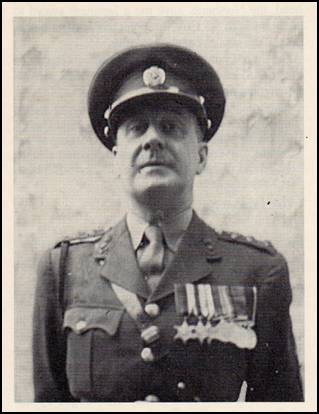
Major
JOHN WILLIAM STEPHEN LISTER
Royal Engineers
(formerly 1863544 Warrant Officer Class I)
by
Lieutenant
Colonel Edward De Santis, MSCE, PE, MInstRE
Ó 2020.
All Rights Reserved.

Figure 1. Major John William
Stephen Lister, R.E.
(Photograph courtesy of the Institution of Royal Engineers)
1. INTRODUCTION
The principal references
used in the preparation of this narrative were from a number of sources.
They include census records, official registries in the United Kingdom,
medal rolls, family trees, Army Lists, publications of the Institution of Royal
Engineers, the London Gazette and various internet sources.
All sources are presented in the REFERENCE section at the end of the
narrative and are cited throughout in the ENDNOTES.
Every effort has been made to accurately portray the life and military
service of Major Lister. Major
Lister’s service papers will not become available to the general public until
after the 15th of May 2021; that is, after 25 years from the date of
his death. These papers, if
available, will provide many details regarding his military service.
If and when they are obtained the information contained therein will be
added as an addendum to this narrative.
John William Stephen Lister’s grandparents were Joseph Lister (1845-1892) and Eliza Lister, née Mason (1846-1903). His father, John Stephen Lister,[i] was born on the 24th of October 1870 in Ringmer, near the town of Lewes in the County of Sussex.[ii]
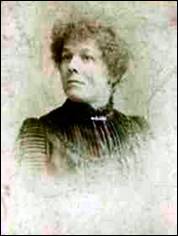
Figure 2. Eliza Lister
(1846-1903).
(Photograph courtesy of the Hunter family tree)
John Stephen Lister attested for service in the 4th Dragoon Guards on the 9th of April 1894 and served in India from about 1895 to 1903.[iii] For his service he received the Indian General Service Medal 1895-1902 with clasp [PUNJAB FRONTIER 1897-98].[iv] This clasp was awarded to troops involved in the defense of Shabkadr Fort, the Mohmand Field Force and the Tirah Expeditionary Force. These operations took place in the Punjab between the 10th of June 1897 and the 6th of April 1898. He returned to England sometime in early 1903
and was mustered out of the Army at Canterbury after 8 years and 322 days of active service, his total time abroad, presumably in India, amounting to 7 years and 310 days. His attestation required him to serve an additional 3 years and 43 days in the Reserve for a total of 12 years with the Colours.
On the 30th of March 1903, while still a member of the Army Reserve, John Stephen Lister joined the Metropolitan Police Force as a Constable, warrant number 89689,[v] and was assigned to the Royal Protection Squad, the elite unit responsible for protection of the royal family and London’s diplomatic community. He completed his 12 years of military service on the 8th of April 1906 while serving with the Metropolitan Police and received his discharge from the Army. About this same time he married Hettie Ann (“Annie”) Bunce at Woolwich.[vi]
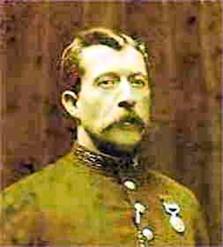
Figure 3. Police Constable
John Stephen Lister, circa 1905.
(Photograph courtesy of the Hunter family tree)
NOTE: In Figure 3 above
John Stephen Lister is wearing his India General Service Medal on his police
tunic.
The principal character of this study, John William Stephen Lister, was born in London on the 14th of April 1910.[vii] The family’s address at the time of his birth was 1 Stanhope Gardens, Kensington SW7. This address is located near the present Gloucester Road underground station on the Piccadilly Line. Stanhope Gardens is south of Cromwell Road, north of Old Brompton Road and just west of Queen’s Gate. It is also located to the southwest of the Natural History Museum.[viii] The current building at this address is a modern structure. The old Lister family residence is gone.
John’s birth was registered in Kensington, sub-district of Brompton in
the County of London on the 23rd of April 1910.
He was baptized on the 29th of May at St. John’s Parish in
Woolwich by Vicar Stuart Churchill.[ix]
|
Figure 4. John Stephen Lister, circa 1905. |
Figure
5. The Lister Family, circa 1905. |
Figure
6. Hettie A. Lister, circa
1905. |
|
(All photographs courtesy of the Hunter family tree) |
||
1911
Census of England and Wales
|
Census
Place: 2 Stanhope Gardens,
Kensington SW |
|||||
|
Name
and Surname of each Person |
Relation |
Marital
Status |
Age |
Profession
or Occupation |
Birthplace |
|
John
(Stephen) Lister |
Head |
Married |
40 |
Police
Constable |
Sussex,
Ringmer |
|
Hettie
(Ann) Lister |
Wife |
Married |
37 |
Caretaker |
Hampshire,
Eastney |
|
Florence
(Edith) Lister |
Daughter |
|
5 |
|
London,
Kensington |
|
John
(William Stephen) Lister |
Son |
|
7
mos |
|
London,
Kensington |
|
Sarah
Bunce |
Mother
in Law |
Widow |
68 |
|
Chatham, |
|
Doris
(Mabel) Bunce |
Niece |
|
14 |
|
Sussex,
|
NOTE: The middle names shown in parentheses above were not included in the census document. They have been added by the author for completeness and clarity.
The Lister’s daughter, Florence Edith, is shown in the census return as being 5 years old. The Hunter Family Tree indicates that she was born on the 9th of January 1905 in Kensington, London; therefore, the family photograph in Figure 5 above can be dated to 1905 with Hettie holding her newborn daughter.[x] Doris Mabel Bunce was the daughter of James Francis Bunce, the brother of Hettie Lister.
Young John was only five years old when his father went off to serve in the Great War of 1914-1918. John Stephen Lister took leave from the Metropolitan Police to enlist in as a Private in the Army Service Corps, Regimental Number R4/089149, and went to France on the 23rd of April 1915. He rose to the rank of Corporal during the war and was demobilized on the 28th of February 1919 and transferred to the Class “Z” Army Reserve.[xi] On the 12th of January 1921 John Stephen Lister received the medals that he earned for his service during the Great War. These included the 1914-15 Star, British War Medal and Victory Medal, which are shown in the figure below from left to right.
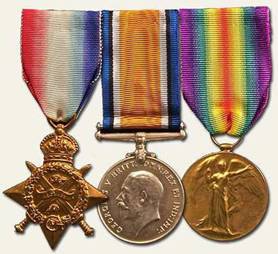
Figure 7. Medals of the Type
Earned by Corporal John Stephen Lister, A.S.C.
(Photograph from the author’s collection)[xii]
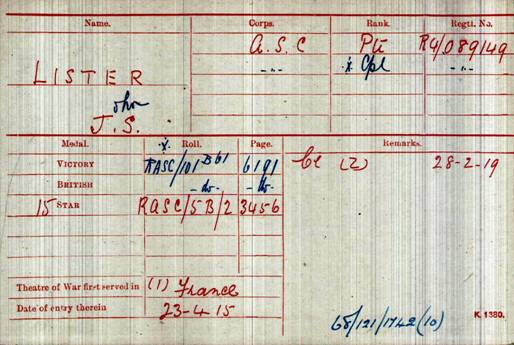
Figure 8. Medal Index Card
of John Stephen Lister (front).
(Image courtesy of Ancestry.com)
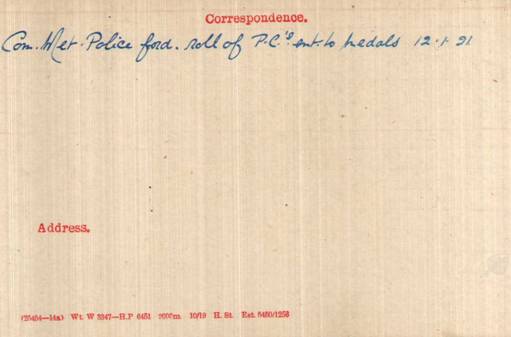
Figure 9. Medal Index Card
of John Stephen Lister (back).
(Image courtesy of Ancestry.com)
John Stephen Lister returned to his police duties following the end of the Great War and was posted to F Division (Kensington) as a Police Constable. He left the Metropolitan Police Force on the 26th of December 1924 with a pension (Pension No. 27,302) in the amount of £106 3s. 9d. He was at the time of his retirement 54 years of age and appears to have been suffering from ill health. He died on the 2nd of January 1925 at Westminster Hospital in London, only seven days after leaving the police force. He certainly must have been suffering from a terminal illness at the time of his leaving the force.
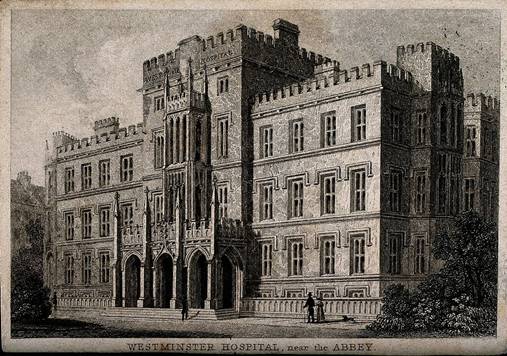
Figure 10. Westminster
Hospital, London.
(Image courtesy of Wikipedia.com)
3. ENLISTMENT AND
TRAINING
Enlistment (1924-1928)
John William Stephen Lister trained and worked as a carpenter until he was 14 years of age when he attested as a Boy Soldier in the Royal Engineers. This is something that one could anticipate given the circumstances of the family. With his father deceased there may not have been much of a family income in 1924. Having the only male in the family join the Army meant one less mouth to feed for Hettie Lister who was then 50 years old.
Once in the Army John trained as a Boy Soldier at Gosport in the School of Electric Lighting and at Chepstow in the Army Technical School.[xiii] On the day of his 18th birthday, 14 April 1928, Lister enlisted as a Sapper, Regimental Number 1863544.
Training
(1928-1929)
Upon joining the ranks as a Sapper he was posted to the Chatham depot where he was trained for a year in infantry drill and pioneer duties at the School of Military Engineering.[xiv]
4.
ASSIGNMENTS AND CAMPAIGN SERVICE
Germany
(1929-1934)
When his training at Chatham was completed Sapper Lister was posted to
duties in Germany. In June of 1931
he was awarded a First Class Certificate of Education[xv]
on the results of a periodic examination held by the Council of Military
Education. Apparently he was
well-educated and was able to obtain the First Class Certificate directly,
without first obtaining the Third and Second Class Certificates.
First Class Certificates were a great deal more difficult and were
required for commissions from the ranks.[xvi]
To received this certificate he had to read and take dictation from any
standard author; make a fair copy of a manuscript; demonstrate his familiarity
with more complicated mathematics and be well versed in British history and
geography.[xvii]
On the 6th of January 1934 Lister was promoted to the rank of
Lance Corporal.
Chatham, Kent (1934-1937)
Upon his return home Lance Corporal Lister was posted to “M” Company
of the Depot Battalion, Royal Engineers at Chatham.[xviii]
The Depot Battalion at the time of Lister’s arrival in the unit was
commanded by Lieutenant Colonel D.McA. Hogg, MC, R.E.[xix]
“M” Company was commanded by Captain A.A.C. Walker, R.E.
Within “M” Company, Lister specifically served under Lieutenant P.R.A.
Millar, R.E.,[xx]
the Officer-in-Charge of Boys Training. In
July of 1935 Lister extended to complete 12 years with the Colours.
On the 12th of January 1936 he was appointed Temporary
Corporal in “M” Company where he served as cadre in the Boys Training
section. He was particularly suited
for this posting as he had been a Boy Soldier himself.
On the 1st of April 1936, while still serving in “M”
Company, Lister was promoted to the rank of Corporal and was selected to attend
the Foreman of Works Class No. 90 at Chatham.
He successfully completed this course in August of 1936.
By this time the Depot Battalion was commanded by Lieutenant Colonel E.N.
Evelegh,[xxi]
DSO, MC, R.E.[xxii]
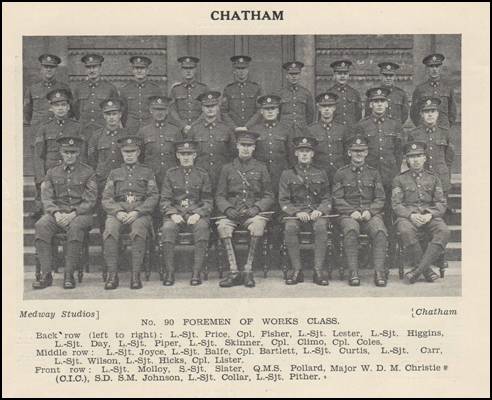
Figure 11.
No. 90 Foreman of Works Class, Chatham, Kent, 1936.
(Corporal Lister is the last man on the far right in the middle row)
(Photograph courtesy of The Sapper magazine, August 1936.)
Lichfield, Staffordshire (1937-1939)
By
early 1937 Lister was serving at Whittington Barracks in Stafforshire.
Whittington Barracks was located in Lichfield, just north of Birmingham.
It was the headquarters and depot of the South Staffordshire Regiment and
the Prince of Wales (North Staffordshire) Regiment.
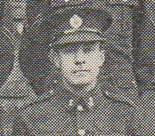
Figure 12.
Corporal John William Stephen Lister, R.E., circa 1936.
(Photograph courtesy of The Sapper magazine, August 1936)
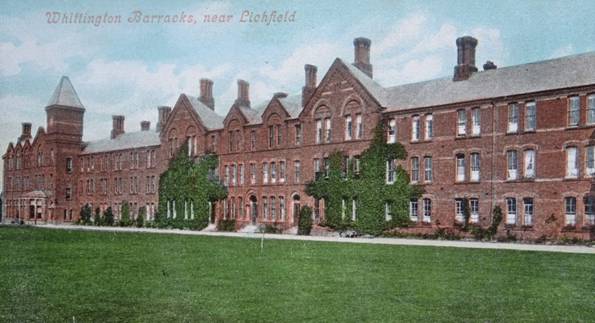
Figure 13.
Whittington Barracks, Lichfield.
(Postcard photograph courtesy of Wikipedia)
Up to this point in his service Lister appears to have been following a path that would have him follow a career path in the Establishment of Engineer Services (E.E.S) of the Royal Engineers. The term Establishment for Engineer Services or Royal Engineer Works Service was used for a number of years in the 20th century to describe the duties of the Royal Engineers in connection with building construction and the use of materials. This establishment dealt with the construction of fortifications, but by and large its greatest responsibility was in the area of the construction and maintenance of barracks. Other works undertaken by the Establishment included hospitals and Army Ordnance buildings. With regard to the latter, the work included not only the buildings themselves, but also the provision and maintenance of fixed machinery and the construction and maintenance of magazines and buildings for the storage of explosives, with special attention to precautions against fire and protection against lightning. Since Whittington Barracks was home to the headquarters and depots of two infantry regiments, it seems likely that the Works. Establishment at Lichfield would have been rather extensive.
At some time prior to autumn of 1939 Lister returned to Chatham for an advanced Foreman of Works course. Lister’s service with the Works Service must have been exemplary as he was a Foreman of Works Staff Sergeant at the time of the birth of his son Robert John at Warwick on the 19th of October 1939.
France
(1939-1940)
Staff Sergeant Lister was assigned to a unit in the British Expeditionary Force in France sometime in 1939 or 1940. Unfortunately his service papers will not be available for review until 2021 (the 25th year following his death) so his exact assignment cannot be known at this time. However, his Memoir posted in The Royal Engineers Journal of August 1996 indicates that he was evacuated at Dunkirk. More details about his posting will not be available until after the 15th of May 2021.
Africa,
Italy, France and Germany (1940-1945)
Foreman of Works Staff Sergeant Lister embarked at Liverpool and traveled via Cape Town to Port Suez.[xxiii] His second period of World War 2 service was not to start in a major theater of the war, but rather in a much more obscure but exotic area. Much of his war service was in Eritrea, Abyssinia and the Sudan where he worked on the following projects and was responsible for recruiting and supervising large forces of labor consisting of local tribesmen:
During the time that Lister was in Eritrea there were a number of actions fought against the Italian forces there. One significant action was the battle of Keren. The battle of Keren (or Cheren, the old Italian spelling) was fought as part of the East African Campaign. The engagement took place from the 5th of February to the 1st of April 1941, between a mixed Italian army of regular and colonial troops and British (mostly Sudanese and Indian troops) and Free French forces. The town of Keren, in the colony of Italian Eritrea, was of strategic importance to both sides in 1941. The road and railway through Keren were the main routes to the colonial capital at Asmara and the Red Sea port of Massawa, which surrendered to the British after the battle.
Ultimately
Lister was assigned to the 8th Army in North Africa and he was with
units that worked their way in the push up through Italy maintaining the road
systems so necessary for the advance. At
the war’s end he was served in France and Germany.
As with his service with the British Expeditionary Force in 1939 and
1940, the details of his service will not be uncovered until the 25 years since
his death have passed. What is known
about this period of his service is that on the 2nd of October 1942,
as a War Substantive Regimental Sergeant Major, Lister was appointed to be a
Temporary Lieutenant (Surveyor of Works) (Army Number 274367).[xxiv]
During
the Second World War quantity surveying was a reserved occupation from the
outset and in 1939 firms of quantity surveyors were appointed by the Army to
supervise both the execution of works and establishing the costs of the cost
plus contracts under which hutted camps were required to house the military.
From the beginning of and throughout the war there was a quantity surveying
division in the War Office, Directorate of Fortification and Works. In 1926 the
Royal Engineers had established the post of Surveyor of Works who was a
commissioned officer. These were assisted and supported by civilian staff of
quantity surveyors and technical assistants. By 1939 there were about 54
Surveyors of Works and at their peak the number rose to about 280 with about 300
assistants, many served in the Middle East, India, Iraq and Italy.
Lister had worked very hard after enlisting in the Army to educate
himself and over the years he had obtained professional qualifications as a
Clerk of Works and Quantity Surveyor. In
fact, he was one of the last Quantity Surveyors in the Royal Engineers Works
Service before responsibilities were transferred to the Ministry of Public
Buildings and Works (MPBW).[xxv]
On the 20th of December 1942 Lister was promoted to the rank
of Warrant Officer Class II in the Regular Army, having served 11 years and 247
days in the ranks and on the 22nd of June 1945 he was promoted to the
rank of Warrant Officer Class I after only 2 years and 182 days as a Warrant
Officer Class II. For his service in
World War 2 WO I and Temporary Lieutenant John William Stephen Lister was
awarded the following service medals:
·
The 1939-45 Star
·
The Africa Star with
clasp [8TH ARMY]
·
The Italy Star
·
The France and
Germany Star
·
The War Medal
Singapore
(1946 -1950)[xxvi]
Lister
was posted to one of the units stationed in Singapore after the war.
The Royal Engineers units there at the time consisted of the Singapore
Engineer Regiment commanded by Lieutenant Colonel O.J.R. Orr, R.E.; a map depot;
and 2 Air Survey Liaison Section. The
work of the Royal Engineers consisted of refurbishing pre-war barracks at
Blakang Mati, Changi, Tanglin, Nee Soon and Gilman Barracks in Alexandria, a
subzone region located in the town of Bukit Merah.
Work also included construction of new depots, stores and workshops and
accommodation for troops, as well as married quarters, churches, gymnasia,
institutes and playing fields, all work suited for a Clerk of Works and Quantity Surveyor.
On the 13th of April 1946 Lister completed 18 years of service
and became eligible for the award of the Long Service and Good Conduct Medal (GVIR)
with bar [REGULAR ARMY]. In August
of 1946 he re-engaged to complete 22 years with the Colours and on the 4th
of October 1946 he was commissioned a 2nd Lieutenant (Regular Army
Short Service Commission).[xxvii]
John’s family was able to accompany him on his posting to Singapore.
On the 23rd of May 1947 his wife and two sons departed from
Tilbury aboard RMS Otranto
bound for
Singapore.
The family had been living at the time in Married Quarters at Old Park
Barracks in Dover, Kent, probably where Lister had been posted for a while
between the end of the war and his assignment to Singapore.
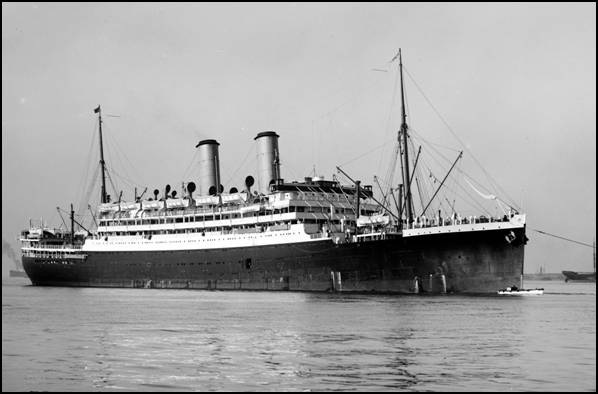
Figure 14.
RMS Otranto, Tilbury to
Singapore, May 1947.
(Photograph courtesy of Wikipedia)
Lister
was promoted to the rank of Lieutenant on the 1st of June 1947 and
was then appointed a Temporary Captain on the 2nd of September.
His wife and two sons arrived at Liverpool from Singapore aboard HMT Empire Halladale, a troopship, on the 27th of February
1950.[xxviii]
It is not known whether this was the family’s return voyage home
following Lister’s posting to the UK from Singapore.
Since the only Lister children shown on the ship’s manifests were his
sons, the location of his daughter at this point is unknown.
For
his post-war service in Singapore, Lister was awarded the General Service Medal
1918 with clasp [MALAYA]. This medal
was awarded for service in the Colony of Singapore for one or more days of
service from the 16th of January 1948 to the 31st of
January 1959. The clasp [MALAYA] was
awarded for service in Singapore from the 16th of June 1948 to the 31st
of January 1959.
Home Service (1950-1953)[xxix]
Lister was
posted home from Singapore, but the unit and nature of his assignment are not
known at this point. On the 19th
of September 1951 he was promoted Lieutenant (Quartermaster) and appointed a
Temporary Captain (QM). He was
appointed a Temporary Major on the 18th of May 1952 and the June and
July Supplements to the London Gazette (17 June 1952 and 4 July 1952) cite the
following, respectively:
“Lt.
(Qr.-Mr.) J.W.S. Lister (274367) to be Capt. (Qr.-Mr.) with seniority 19th
Sept. 1951.”
“Lt.
John William Stephen Lister (274367) from Serv. Commn.
To be Lt. (Qr.-Mr.), 18 June 1952, with an antedate for seniority
purposes only to 19th Sept. 1951 and precedence next below F.H.B.
Climo (422739).”
NOTE:
The promotions and appointments to various ranks are most confusing and
typical of the bureaucratic operations of the British War Office.
It also is interesting to note the Lister’s Army Number, 274367, is
much lower than Climo’s 422739, yet Lister’s date of rank is below (later
than) that of Climo.
The
confusion persists when Lister reverts to the rank of Captain (QM) on the 4th
of January 1953, presumably from his appointment as a Temporary Major on the 18th
of May 1952 and then he is re-appointed a Temporary Major on the 1st
of May 1954. Presumably these
appointments have something to do with the assignments that he was given during
this period, but without his service papers just what these assignments were
cannot be known at this time. From
his Memoir printed in the R.E. Journal of August 1996, it appears that some of
this service in the UK may have been in Northern Ireland.
Germany (1953-1955)[xxx]
It appears that Lister was posted to Germany sometime about 1953 and was
assigned to the major military headquarters at Mönchengladbach, a
city in North Rhine-Westphalia, Germany, located west of the Rhine, halfway
between Düsseldorf and the Dutch border.[xxxi]
While assigned there he was assigned to the British Army of the Rhine
tendering and letting major contracts and works supervision in both Germany and
Antwerp, Belgium. These assignments
were with the Royal Engineers Works Service.
Home
Service (1955-1964)[xxxii]
On the 30th
of December 1955 Lister was assigned as a Quantity Surveyor, Engineer Staff in
the Quartermaster General’s Branch of the Aldershot District.[xxxiii]
In 1960 the responsibilities of the R.E. Works Service to which Lister
was assigned were transferred to the Ministry of Public Buildings and Works.
The Supplement to the London Gazette dated 14 March 1961 published the
following with regard to Lister;
“Maj.
(Q.M.) J.W.S. Lister (274367) retires on retired pay (Reserve Liability).”
His
actual date of retirement was the 11th of March 1961.
The
Regular Reserve of the Army largely consisted of ex-Regular personnel who
retained a statutory liability for service and were liable to be recalled for
active military duty in case of imminent national danger or great emergency.
Lister was placed in this category in 1961.
On
the 11th of May 1964 a reduction in the force led Lister to retire
from the Army after 37 years of service. It
is assumed that on this date he no longer had a Reserve Liability and he was
transferred to the Regular Army Reserve of Officers.
On the 14th of April 1965 he ceased to belong to the Regular
Army Reserve of Officers “having attained the age limit” for service.[xxxiv]
The following sections are presented in tabular form to summarize
Lister’s promotions, appointments, military training and qualifications and
the medals that he was awarded during his time in the Army.
They are provided to give the reader easy access to these aspects of
his military career. The tables
are followed by sections dealing with his marriage, personal information and
post-service life.
Lister received the following promotions and appointments during his time in service:
Date of Promotion |
Rank
|
|
1924 |
Attested as a Boy Soldier in the Royal Engineers. |
|
14 Apr 1928 |
Enlisted as a Sapper in the Royal Engineers. |
|
6 Jan 1934 |
Promoted to the rank of Lance Corporal. |
|
12 Jan 1936 |
Appointed Temporary Corporal. |
|
1 Apr 1936 |
Promoted Corporal. |
|
Date Unknown |
Promoted Lance Sergeant. |
|
Date Unknown |
Promoted Sergeant. |
|
Pre-Oct 1939 |
Promoted Foreman of Works Staff Sergeant. |
|
Date Unknown |
Appointed War Substantive Regimental Sergeant Major. |
|
2 Oct 1942 |
Appointed to be Lieutenant (Surveyor of Works). |
|
20 Dec 1942 |
Promoted Warrant Officer Class II. |
|
22 Jun 1945 |
Promoted Warrant Officer Class I. |
|
4 Oct 1946 |
Commissioned 2nd Lieutenant (Regular Army Short Service Commission). |
|
1 Jun 1947 |
Promoted Lieutenant. |
|
2 Sep 1947 |
Appointed Temporary Captain. |
|
19 Sep 1951 |
Promoted Lieutenant
(Quartermaster) and appointed Temporary Captain (QM).(1) |
|
18 May 1952 |
Appointed Temporary Major. |
|
4 Jan 1953 |
Reverted to Captain (QM). |
|
1May 1954 |
Appointed Temporary Major. |
|
7 Aug 1956 |
Promoted Major (QM)(Regular
Army)(2) |
NOTES: The Royal Engineers List of 1962 provides the following information in the Retired List of that publication.
(1) Date of First Commission: 19 September 1951.
(2) Substantive Rank: 7 August 1956.
6.
MILITARY TRAINING AND QUALIFICATIONS
a. Military Training: Lister received the following military training during his time in service:
Dates |
Course
of Training |
|
1928-1929 |
School of Military Engineering. |
|
1 Apr 1936 |
Completed Foreman of Works Class No. 90. |
|
1939 |
Attended Foreman of Works Course. |
b. Qualifications: Lister earned the following qualifications during his time in service.
Date |
Qualification |
|
Jun 1931 |
Awarded First Class Certificate of Education. |
|
2 Oct 1942 |
Appointed Surveyor of Works. |
|
19 Sep 1951 |
Appointed Quartermaster. |
|
30 Dec 1955 |
Appointed Quantity Surveyor. |
Major Lister received the following medals, awards and decorations during his time in service. They are shown below, from left to right, in Figure 15.
|
Dates
of Qualification |
Medal
or Award |
|
3 Sep 1939 – 15 Aug 1945 |
1939-45 Star |
|
10 Jun 1940 – 12 May 1943 |
Africa Star with bar [8th ARMY] |
|
11 Jun 1943 – 8 May 1945 |
Italy Star |
|
6 Jun 1944 – 8 May 1945 |
France and Germany Star |
|
3 Sep 1939 – 2 Sep 1945 |
War Medal |
|
16 Jun 1948 – 31 Jan 1959 |
General Service Medal 1918 with clasp [MALAYA] |
|
13 Apr 1946 |
Long Service and Good Conduct Medal (GVIR) with bar [REGULAR ARMY] |
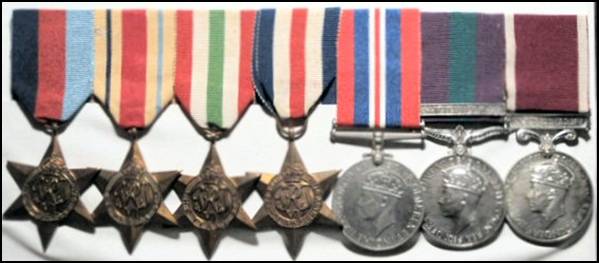
Figure 15. The Medals of
Major John William Stephen Lister, Royal Engineers.
(Photograph from the author’s collection)
8.
ADDITIONAL FAMILY INFORMATION
John William Stephen Lister married Anne Mabel Thomas[xxxv] on the 2nd of January 1937. Anne had been a domestic servant, probably in a household in Gillingham, Kent. At the time of their marriage Anne resided at 40 Parr Avenue in Gillingham.
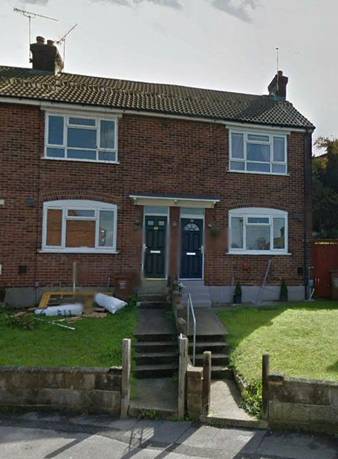
Figure 16. The Thomas
Residence at 40 Parr Avenue, Gillingham, Kent.
(40 Parr Avenue is the building on the left)
(Photograph courtesy of Google Earth)
The Listers were married in the Parish Church in Gillingham. Their marriage certificate indicates that Anne’s father, Arthur Thomas, a dockyardsman, was deceased. Witnesses to the marriage included Lilly Matilda Gill and Hettie A. Lister, the groom’s mother. As previously indicated, Lister was serving at Whittington Barracks in Staffordshire at time of the wedding.
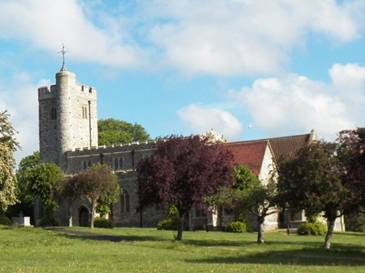
Figure 17. The Parish Church
in Gillingham, Kent.
(Photograph courtesy of Wikipedia)
As previously noted, John’s father had died at an early age back in 1925. His mother, Hettie died on the 15th of December 1951 in Chelsea, London. The Lister’s daughter Florence Edith was born on the 9th of January 1905 in Kensington, London. She married Sydney McCluan Hunter (1905-2000) and they had two children. Florence died in Dulwich Hospital in 1995.
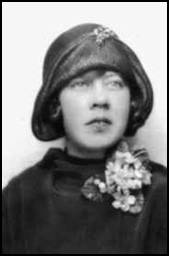
Figure 18. Florence Edith
Lister, c. 1925.
(Photograph courtesy of the tree6244 Family Tree)
Their first son, Robert John, was born on the 19th of October
1939 at Warwick Hospital. Robert
John Lister was living in Wilmslow, Cheshire in 1996 at the time of his
parent’s tragic automobile accident, which took their lives (see Section 10
below). The
Royal Engineers List of Non-Serving Members and Widows dated December 2019 shows
Robert John Lister still living at the same address.
Robert was employed as a computer consultant with Tantalum Computer
Services Limited in Wilmslow. He
became the Director of the firm in 1991.
Son number 2, David Stephen, was born in Maidstone, Kent in 1946. He was living in Abingdon, Oxon in 1996 when his parents were killed. Like his father he became a Quantity Surveyor and is the director of Lister Construction Management, Ltd. in Abingdon, a firm that was incorporated in 2009.
9. RELEASE FROM SERVICE
Major Lister was released from service (the Reserve of
Officers) on the 14th of April 1965, having attained the maximum age
for continued service. His total
service was reckoned as shown in the tables below.
Note that without access to his service papers the dates shown in the
table are approximate and have been noted by years rather than actual dates;
that is days and months. In some
cases the dates represent only partial years.
Also, where Home Service is noted this designation of location had to be
used since the non-availability of his service papers do not allow for a precise
location.
Location |
Period
of Service |
|
Gosport and Chepstow (as a Boy Soldier) |
1924-1928 |
|
Chatham (School of Military Engineering) |
1928-1929 |
|
Germany |
1929-1934 |
|
Chatham (School of Military Engineering) |
1934-1937 |
|
Staffordshire |
1937-1939 |
|
B.E.F. France |
1939-1940 |
|
Africa, Italy, France and Germany |
1940-1945 |
|
Singapore |
1946-1950 |
|
Home Service |
1950-1953 |
|
Germany |
1953-1955 |
|
Home Service |
1955-1961 |
|
Reserve Service |
1961-1965 |
Location |
Period
of Service |
|
Home
Service |
18 years |
|
Service
Abroad |
19 years |
Total Service (Active): |
37 years (not counting Boy Soldier service) |
Total Service (Active and Reserve): |
41 years |
NOTE: The Royal Engineers List of 1970, page 38 shows his “Years
served” as 1951 – 1961. Since
the Royal Engineers list is published by the Institution of Royal Engineers and
its membership consists of officers, active and retired, this list only is
considering his service from the date of his first commission (19 September
1951) to the date of his retirement (11 March 1961).
Neither his service in the ranks nor his reserve service are included in
this “Years served” range.
10.
POST SERVICE LIFE
In 1962 Lister and his wife were living at 101 Courtland Road in Iffley, Oxford. At this time he is shown in The Royal Engineers List of 1962 as a Major (Q.M.) on the Retired List.
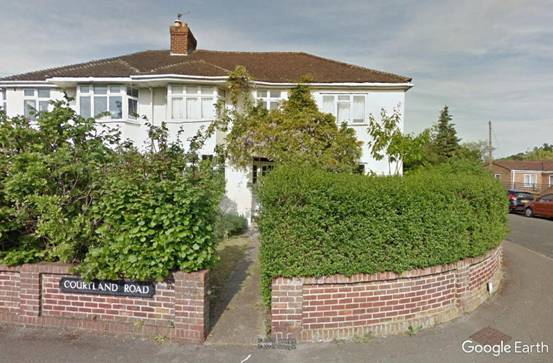
Figure 19. The Lister
Residence at 101 Courtland Road, Iffley, Oxford.
(Photograph courtesy of Google Earth)
In 1964, after leaving the active Army, Lister took a position as Clerk of Works for the Oxford City Council. He worked on the construction of the new Oxford County Offices which were opened by Her Majesty Queen Elizabeth in 1976 and he was introduced to Her Majesty during the opening ceremonies.
Lister had become a Member of the Institution of Royal Engineers immediately upon his retirement from the Army. He is listed as a retired member in The Royal Engineers List from 1962 through 1995.[xxxvi]
On the 16th of October 1974 the Hertford Construction Services Limited, a private limited company, was incorporated in Oxford. Although Lister was in “semi-retirement” it appears that he remained active in this family business and served as the Director for a time from the company’s office address at 8 King Edward Street in Oxford.[xxxvii]
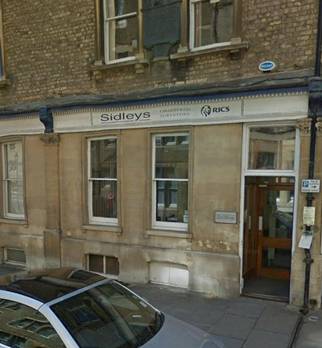
Figure 20. 8 King Edward
Street, Oxford, circa 2019.
(Photograph courtesy of Google Earth)
The last annual return of Hertford Construction Services Limited was made on the 29th of December 1988 when the company was dissolved. At this time Lister and his wife were residing at 6 Lovell Close in Ducklington, near Witney, Oxfordshire.
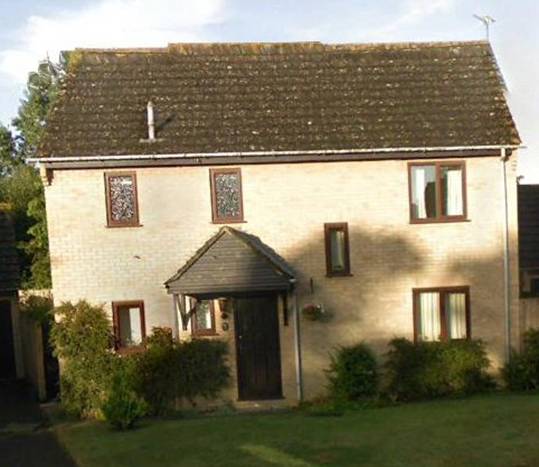
Figure 21. 6 Lovell Close,
Ducklington, near Witney, Oxfordshire.
(Photograph courtesy of Google Earth)
Following the closing of the family business Lister appears to have fully retired. He was an enthusiastic gardener and being proud of his military service he remained a retired member of the Institution of Royal Engineers right up until the time of his death.
John William Stephen Lister and his wife Anne were tragically killed in an automobile accident in Witney that occurred on the 14th of May 1996. Anne Lister died at the scene of the accident and John succumbed to his injuries on the following day. The accident was publicized in the Witney Gazette of 22 May 1996 and the details are presented in the article below:
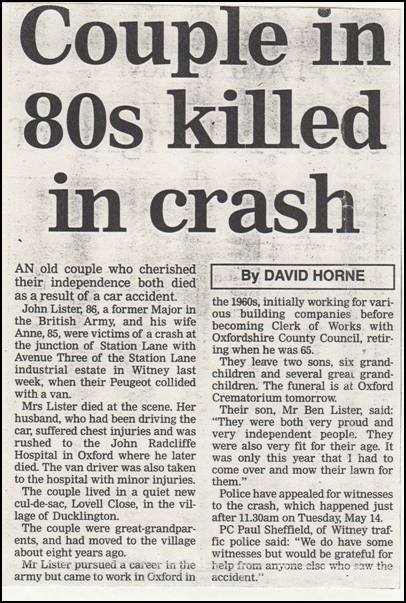
Figure 22. Article from the
Witney Gazette, 22 May 1996.
(Courtesy of Mr. R. Peattie of Witney, Oxon)
John Lister died on the 15th of May 1996 from heart failure as a result of the accident the previous day. His death certificate indicates that he died at John Ratcliffe Oxford, Oxford Ratcliffe Hospital of multiple injuries. The John Ratcliffe (JR) Hospital is Oxfordshire’s main accident and emergency facility. It provides acute medical and surgical services including trauma, intensive care and cardiothorasic services. The hospital is located in Headington, about three miles east of Oxford city center. As fine a medical facility as it was, John Lister’s injuries, couple with his age, were too serious for him to have survived.
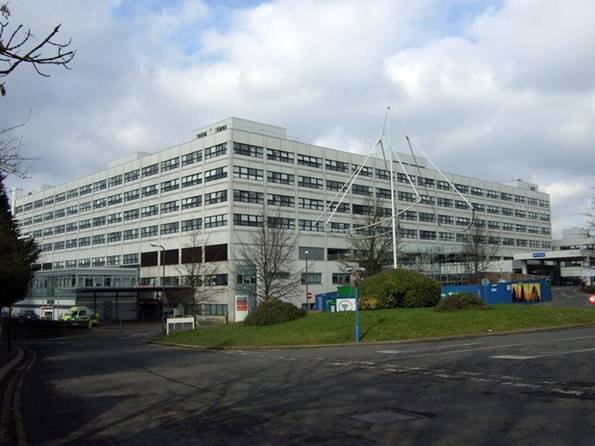
Figure 23. John Ratcliffe
Hospital, Oxfordshire.
(Photograph courtesy of Wikipedia)
The Lister’s funeral was held at the Oxford Crematorium on the 23rd of May 1996. John Lister’s will was probated in Oxford on the 1st of August 1996. His heirs specifically mentioned in his will included his wife[xxxviii] and both sons as well as his grandson, Matthew David Lister, to whom he bequeathed his car. Note that since the will was made in 1992 with no foreknowledge of the impending automobile accident, young Matthew presumably would have inherited the Peugeot, which may or may not have been a total loss in the accident. The Salvation Army also was mentioned in the will as the recipient of his wardrobe.
An inquest was held on the 7th of August and a death certificate was received from N.G. Gardiner the Coroner for Oxfordshire. John’s death was registered on the 9th of August 1996 by Val Farrant, the Registrar for Oxfordshire.
REFERENCES:
Books
LETTS, C. Roadbook of Britain. Charles Letts and Company Limited, London, 1977.
9.
SKELLEY, A.R.
The Victorian Army At Home: The
Recruitment and Terms and Conditions of the British Regular, 1859-1899.
Mc Gill-Queen’s University Press, Montreal, 1977, p. 94, 95, and 311.
Census
1911 Census of
England and Wales.
Correspondence
Documents
Family Trees
Internet Web Sites
https://beta.companieshouse.gov.uk/company/01187540
https://www.unithistories.com/officers/Army_officers_L01.html
https://en.wikipedia.org/wiki/Regular_Reserve_(United_Kingdom)
London and Edinburgh Gazettes
Medal Rolls
Military Service Papers
Periodicals
Registers
England & Wales, Civil Registration Death Index, 1916-2007.
Royal Engineers Journal
Royal Engineers Lists
Ships Manifests
ENDNOTES
[i] Shown as Leister in some documents but will be shown as Lister in the remainder of this research.
[ii] Family trees from Ancestry.com.
[iii] Short Service Attestation papers.
[iv] Certificate of Discharge.
[v] Register of Leavers from the Metropolitan Police Force.
[vi] Hettie Ann Bunce had been born in Eastney, Hampshire in 1874.
[vii] Birth certificate.
[viii] AA Big Atlas of Town Plans.
[ix] Baptism record from St. John’s church in Woolwich.
[x] Family Tree tree6244.
[xi] Medal Index Card.
[xii] These are not the medals of John Stephen Lister, but rather a photograph of the type of medals that he would have been awarded.
[xiii] The Royal Engineers Journal, August 1996.
[xiv] Skelley.
[xv] The Sapper, June 1931, p. 312.
[xvi] This certificate would help him to obtain his commission some years in the future.
[xvii] Skelley.
[xviii] The Sapper, February 1935, p. 513.
[xix] Douglas McArthur Hogg. Born 23 September 1888, the son of Major General George Crawford Hogg, CB, Bombay Cavalry. Attended Cheltenham College, 1901-1904. Royal Military Academy, Woolwich, 1904-1906. Commissioned 2nd Lieutenant, Royal Engineers, 1906.
[xx] Reginald Aston Millar. Born 1905, the son of J.H. Millar, D.Sc., Dublin. Millar attended Dublin University and graduated with a Bachelor of Arts Degree in 1928. He was commissioned a 2nd Lieutenant in the Royal Engineers in 1929, later Major, R.E. Re: The Fettes College Register.
[xxi] Evelegh had formerly served in the 7th Field Company, R.E. and with the Indian Sappers and Miners.
[xxii] The R.E. Quarterly List, January – October 1935.
[xxiii] The Royal Engineers Journal, August 1996.
[xxiv] Supplement to The London Gazette, 1 June 1943, p. 2521.
[xxv] The Royal Engineers Journal, August 1996.
[xxvi] 1950 is an assumed date of his return to the UK from Singapore.
[xxvii] 1956 Biographical List of Officers, p. 997.
[xxviii] Ship’s Manifest.
[xxix] These dates have been assumed and are approximate.
[xxx] These dates also are approximate.
[xxxi] Until December 2013, the Rheindahlen Military Complex was located just outside Mönchengladbach, where it was home to the headquarters of the British Armed Forces in Germany.
[xxxii] Approximate dates.
[xxxiii] The Army List, 1956, pp. 65 and 604a.
[xxxiv] Supplement to The London Gazette, 16 April 1965.
[xxxv] Anne Mabel Thomas was born on the 29th of July 1910.
[xxxvi] Lister is not listed in the 1996 edition as he died in May of 1996 and the list was corrected up to the 21st of October of 1996.
[xxxvii] These premises are now occupied by Sidleys Chartered Surveyors.
[xxxviii] Provision was made in his will for distribution of his effects should his wife pre-decease him, as was the case.